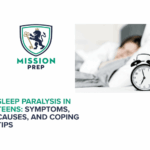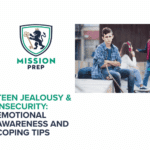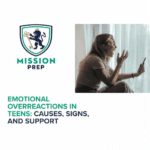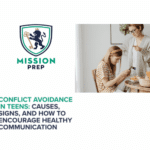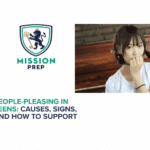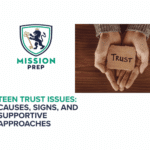Teen Fear of Abandonment: Emotional Signs and Coping Strategies

Feeling safe in our environment and supported by loved ones is a basic necessity. When that need isn’t met, we can suffer both physically and emotionally. This is especially true during adolescence, a time that can be so pivotal in development. While there are often positive changes during adolescence, such as increased independence, challenges can also arise. Stress, uncertainty about the future, and added responsibilities can all weigh heavily on teens today.
Unfortunately, all this pressure tends to have negative effects if a teen doesn’t have the right support. One possible outcome is the development of attachment issues and a fear of being left or abandoned by other people. Teen fear of abandonment is a problem that some will face, and, without reparative experiences, can be linked to other mental health problems.
If you suspect your child is showing a fear of abandonment, a mental health professional can help you uncover the potential underlying factors and discuss suitable treatment options. This page can also help you better understand teen fear of abandonment by exploring:
- What teen fear of abandonment is
- Recognizing attachment issues in teens
- Teen mental health problems
- Therapy for abandonment issues
- Parental support for anxious teens

Understanding Teen Fear of Abandonment
Teen fear of abandonment is a complex emotional issue. At its core, the fear is that relationships aren’t stable, that they can’t be relied upon, and that they won’t last.1 When a person has a fear of abandonment, they believe that the people close to them won’t always be there to provide emotional support, safety, and stability in their lives. This pattern of thinking can lead teens to use negative coping skills. For example, they might cling to others, use aggressive language when they fear a loss, or seek out relationships that might not be healthy for them.
It’s important to understand that this fear may or may not be justified. Some teens may have faced multiple instances of abandonment in childhood, and this may have led them to develop this strong fear. In contrast, others might end up fearing abandonment due to negative thought patterns and cognitive distortions.1 Whether a teen has experienced a traumatic event or not, their fear of abandonment is real, and addressing this fear is crucial for supporting emotional resilience in teens.
Many researchers link a fear of abandonment to attachment theory, which says that we are born with innate attachment behaviors that are designed to protect us from harm.2
Attachment theory suggests that the earliest relationships in our lives, typically between parents and children, are what shape our thoughts and behaviors within relationships.3 Over the years, this theory has developed and become more complex. Now, researchers recognize that even though early relationships provide a strong basis for how we view the world, we can change this through therapy and by developing better coping skills.3
Recognizing Attachment Issues in Teens
Signs of Attachment Issues in Teens:
Depending on the type of insecure attachment, these signs may include:- Withdrawing or isolating from peers and family: Teens who spend most of their time alone or who don’t have a core friendship group may be showing signs of insecure attachment.4 They might also withdraw specifically in situations where they feel like they are to blame for an issue or fear punishment from a parent.
- Fear of failure: When a teen is constantly worried about failing others, this may be a sign that they are experiencing some attachment issues. Teens with attachment insecurity may depend on others to build up their own self-esteem, seeking validation and approval every step of the way. By doing this, they risk not living up to their full potential and relying too much on parents or peers.4
- Mood swings: Living in a constant state of fear that someone will leave you can impact emotion regulation. Teens who show signs of extreme mood swings, such as expressing a need for closeness and affection followed by aggression, are at a greater risk of developing a personality disorder, such as borderline personality disorder (BPD).4
- Forming unhealthy relationships: Entering into risky relationships with peers or engaging in very early romantic relationships can be a sign of an attachment issue. This behavior can lead to adolescents becoming stuck in an abusive relationship at some point in their lives, because they don’t want to lose anyone close to them, regardless of their negative influence.4
Recognizing attachment issues in teens is often crucial to accessing appropriate treatment. This is because attachment issues and fear of abandonment can be closely associated with serious mental health problems.
Teen Mental Health Problems
Several mental health problems are linked to a fear of abandonment and attachment issues in adolescents. Below, we discuss some of the common mental health disorders that teens face today.
Anxiety
There are a few different anxiety disorders that teens can struggle with, including social anxiety disorder (SAD), generalized anxiety disorder (GAD), panic disorder, and posttraumatic stress disorder (PTSD). Recognizing some of the common anxiety symptoms in teens can help parents intervene early.
Early intervention for anxiety involves getting the proper diagnosis and treatment recommendation, which is best-suited for the child. Constant worrying, panic attacks, and problems in school are a few examples of ways that anxiety can express itself in adolescence.5
Depression
People tend to think of major depressive disorder (MDD) when discussing depression in teens. MDD can affect many areas of a teen’s life, from cognition to physical health and interpersonal relationships. Understanding the early warning signs of depression in teens can prevent the problem from escalating. When left untreated, depressive symptoms can worsen to include self-injury, suicidal ideation, and suicide attempts.6
Borderline Personality Disorder (BPD)
Teen fear of abandonment is most commonly associated with borderline personality disorder (BPD). People with BPD tend to be sensitive to rejection, which can further fuel their fear of abandonment. This intense fear can cause teens with BPD to engage in risky behaviors such as self-harm, as BPD symptoms can include cognitive distortions and irrational thinking.7
If your teen is diagnosed with any of the mental health disorders discussed above, we recommend that you seek appropriate support for them.
Therapy for Abandonment Issues
Therapy for abandonment fears in teens comes in many different forms. However, they all focus on building coping strategies for emotional insecurity, promoting healthy relationships, and building self-esteem in teens. The main therapeutic intervention to address fears of abandonment is dialectical behavior therapy (DBT).8
DBT was originally designed to treat women with BPD, but it has been shown to be effective for treating multiple mental health disorders. What makes DBT so effective is that it focuses on teaching and applying practical skills to address emotional issues. These skills cover the four key areas of mindfulness, emotion regulation, distress tolerance, and interpersonal effectiveness. By combining individual therapy with weekly skills groups, DBT encourages teens to work one-on-one with a therapist, and come together with peers and family to put skills to use.8
Adolescent emotion regulation skills include problem-solving and looking at the pros and cons of a situation before reacting. Mindfulness skills can be useful for coping with negative thoughts and fears of abandonment, as well as managing anxiety and fear. These skills might include guided meditations, imagery, paced breathing, and progressive muscle relaxation, among other techniques. By being mindful and focusing on the present moment, teens can shift the focus from fearing what will happen in the future to an acceptance of what is happening right now.8
Finally, the DBT interpersonal effectiveness module promotes healthy relationships and encourages better self-esteem. Teens learn how to communicate effectively in relationships, ask for what they need, and be respectful while remaining assertive. Incorporating these skills can help to combat attachment issues.8
Parental Support for Anxious Teens
Providing support for your teen is vital for reinforcing the skills learned in therapy. By getting the family involved in group sessions, you have the chance to demonstrate healthy communication, emotion regulation, and resilience.
There is also a specific therapeutic model known as “attachment-based family therapy” (ABFT), which targets depression and anxiety in teens by using the research from attachment theory.9 One stage of the treatment aims to build a strong alliance between parents and the child by looking at possible issues with parenting styles in the past. Instead of dwelling on the negatives, though, the therapist uses this information to come up with treatment goals that you can work on with your teen at home.
Taking on your teen’s perspective and understanding their fears can help you adapt your reactions at home to encourage healthier relationships. Knowing your role in your teen’s treatment is the key to ensuring everyone works together as a cohesive family unit.

Mission Prep: Offering Resources for Teen Wellness and Support
If you are beginning to recognize signs of mental health issues in your child, rest assured that you’re not alone. At Mission Prep, we provide mental health services for teens struggling with depression, anxiety, personality disorders, and more.
With options for outpatient therapy, residential mental health facilities, and telehealth therapy, Mission Prep can meet you and your child where you are. Call us today to ask our team any questions or concerns you have. We can provide advice and individualized treatment recommendations to help you get your child back on the path to mental wellness.
References
- Rehman, M. M. U., & Suneel, I. (2025). Abandonment Schema and Limerence: The Mediating Role of Interpersonal Cognitive Distortions among Young Adults. Pakistan Journal of Social and Clinical Psychology, 23(1), 12-18. https://www.researchgate.net/publication/395391011_Abandonment_Schema_and_Limerence_The_Mediating_Role_of_Interpersonal_Cognitive_Distortions_among_Young_Adults
- Mikulincer, M., Shaver, P. R., & Pereg, D. (2003). Attachment theory and affect regulation: The dynamics, development, and cognitive consequences of attachment-related strategies. Motivation and emotion, 27(2), 77-102. https://doi.org/10.1023/A:1024515519160
- Schore, J. R., & Schore, A. N. (2008). Modern attachment theory: The central role of affect regulation in development and treatment. Clinical Social Work Journal, 36(1), 9-20. https://doi.org/10.1007/s10615-007-0111-7
- Brisch, K. H. (2009). Attachment and adolescence. S. Amey, C. Batmanghelidjh, LM Bomber, KH Brisch, M. Delaney, B. Earl, A. Heyno, & DA Hughes. Teenagers and Attachment, 9-31.
- Kaur, A. (2022). The roots of anxiety disorder in children and teenagers; What it is in detail. International Journal of Engineering Research & Technology (IJERT), 11(04). https://doi.org/10.17577/IJERTV11IS040090
- Lewinsohn, P. M., Rohde, P., & Seeley, J. R. (1998). Major depressive disorder in older adolescents: prevalence, risk factors, and clinical implications. Clinical Psychology Review, 18(7), 765-794. https://doi.org/10.1016/s0272-7358(98)00010-5
- Palihawadana, V., Broadbear, J. H., & Rao, S. (2019). Reviewing the clinical significance of fear of abandonment in borderline personality disorder. Australasian Psychiatry, 27(1), 60-63. https://doi.org/10.1177/103985621881015
- Robins, C. J., & Rosenthal, M. Z. (2011). Dialectical behavior therapy. Acceptance and mindfulness in cognitive behavior therapy: Understanding and applying the new therapies, 164-192. https://doi.org/10.1002/9781118001851.ch7
- Diamond, G. S., & Lebow, J. L. (2005). Attachment-based family therapy for depressed and anxious adolescents. Handbook of Clinical Family Therapy, 29, 17-41.

